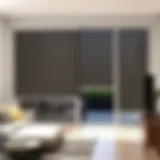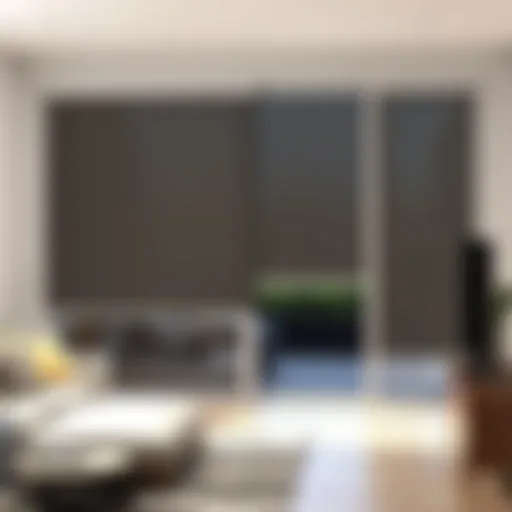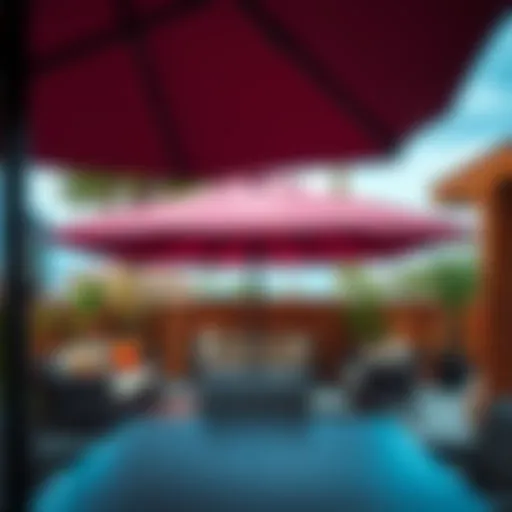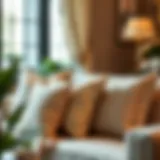Comprehensive Insight into Outdoor Screen Shades
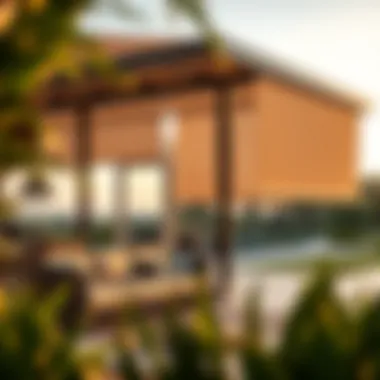

Intro
The allure of outdoor spaces often lies in their ability to serve as an extension of our homes. They provide opportunities for relaxation and social gatherings, yet they can also be subject to harsh sunlight, wind, and insects. This is where outdoor screen shades come into the picture, combining functionality and aesthetic charm to redefine how we interact with our external environments.
In this article, we will explore the various aspects of outdoor screen shades, examining their ability to enhance comfort, reduce energy costs, and elevate the overall design of patios, decks, and more. As we unpack the features available, from materials to installation, we will offer practical insights aimed at homeowners, designers, and DIY enthusiasts eager to create an inviting outdoor oasis.
Understanding the latest trends in outdoor screen shades is crucial for anyone looking to upgrade their outdoor space. Not only does this article delve into current aesthetic preferences, but it also touches on innovative approaches to screen shades that align with sustainability and energy efficiency, making it a must-read for today's discerning outdoor decorators.
Furniture Styles and Trends
As we consider outdoor spaces, it’s essential to appreciate how the design of shades can impact the overall look and feel of an area.
Modern vs. Traditional: Understanding the Aesthetics
When looking at outdoor screen shades, contrasting modern designs with traditional ones reveals several interesting characteristics. Modern styles often focus on sleek lines and minimalistic approaches. They typically utilize materials like aluminum and synthetic fabrics that exude a contemporary charm. Shades in this category might be found in vivid hues or even subtle tonal variations, assuring they're visually appealing without overwhelming the viewer.
On the other hand, traditional outdoor shades evoke a more classic atmosphere. These shades may incorporate natural materials like wood or cotton, often enriched with detailed patterns that tell a story. For instance, a rich striped canvas in warm earth tones might complement an old-world patio setting beautifully.
Tailoring your choice of screen shades to match either a modern or a traditional aesthetic can significantly alter the vibe of an outdoor space.
Color and Material Trends: What's In and What's Out
The color palette for outdoor screen shades is constantly in flux, reflecting the latest design fads while catering to personal preferences. As of late, earthy tones such as terracotta, sage green, and rustic browns have taken center stage. Such hues bring a sense of the outdoors in, grounding the design and making spaces feel inviting. In contrast, bold colors such as bright turquoise or sunshine yellow often serve as accents against more neutral backdrops.
Materials also play a pivotal role in the appeal of outdoor screen shades. Weather-resistant fabrics like acrylic or vinyl-coated polyester are trending for their durability and ease of maintenance. Conversely, sustainable choices like organic cotton or hemp are gaining traction among eco-conscious consumers looking to enhance their outdoor setting without compromising the planet.
To obtain a fresh take on outdoor designs, consider mixing and matching colors and materials creatively, striking a delicate balance between style and functionality.
In summary, understanding the nuances between modern and traditional styles, as well as color and material trends, equips homeowners and designers with essential knowledge to make educated choices for outdoor screen shades.
Furniture Care and Maintenance
Once you've settled on the perfect outdoor screen shades to enhance your space, you’ll want to ensure they stand the test of time. Proper care and maintenance can prolong their life and maintain their aesthetic appeal.
Tips for Prolonging the Life of Your Furniture
- Regular Cleaning: To prevent dirt accumulation, wash your shades with a hose or mild soap regularly.
- Inspect for Damage: Routinely check for wear and tear or any fraying edges and promptly make necessary repairs.
- Seasonal Storage: If you live in an area with extreme weather, consider storing your outdoor shades during the off-season.
- Use Protective Covers: Utilizing covers during adverse weather can shield your shades from potential damage.
DIY Repair Hacks for Common Furniture Issues
Small fixes can often be performed at home without the need for professional help. For example, if the fabric tears, a simple sewing kit can mend minor rips easily.
In cases where the hues have faded, consider using specialized fabric dyes meant for outdoor materials to restore the color without compromising integrity.
Understanding Outdoor Screen Shades
Outdoor screen shades have increasingly become a pivotal element in modern exterior design. They serve not just as a visual accessory, but as a functional necessity that enhances outdoor living spaces. With a growing interest in outdoor environments, understanding these shades is essential for homeowners, designers, and enthusiasts alike. This section elucidates the significance of outdoor screen shades and what they can offer.
Definition and Purpose
Outdoor screen shades, at their core, are devices used primarily to block sunlight while providing an unobstructed view of the surroundings. They come in a variety of designs, from basic mesh fabrics to upscale solar screens, catering to diverse needs. The purpose is manifold:
- Sun Protection: They shield from harmful UV rays, thus protecting both skin and furnishings.
- Temperature Control: By minimizing heat absorption, they keep spaces cooler during scorching summers and warmer when it’s chilly outside.
- Glare Reduction: They help in mitigating glare on screens and surfaces, making outdoor lounging more enjoyable.
- Enhanced Privacy: Strategically installed shades can create secluded areas without blocking natural light completely.
With practical functions merging seamlessly with aesthetics, outdoor screen shades become essential for creating comfortable outdoor areas.
How They Work
Outdoor screen shades operate on straightforward principles yet deliver significant outcomes. The majority utilize a fabric that allows airflow while blocking sunlight. Here’s how they generally function:
- Material Science: Most shades are made from specially designed fabrics that reflect sunlight while still being permeable enough to allow air circulation. This means you can enjoy a breeze without the harsh sunlight.
- Installation Mechanism: Depending on the type, shades can be either fixed or retractable. Retractable shades offer greater versatility, allowing you to adjust the levels of openness based on the time of day or season. Fixed designs, on the other hand, remain in place year-round, offering consistent protection.
- Functionality Integration: Many modern outdoor shades come with automation options, allowing them to function based on temperature sensors, sunlight intensity, or user preferences. This range of functionality facilitates energy savings and enhances comfort.
Understanding how these fabrics and mechanisms work can greatly influence the decision-making process when it comes to selecting the right shade for your space.
"By utilizing outdoor screen shades, homeowners not only improve comfort but also extend the usability of their outdoor areas."
Each design brings something different to the table, making the exploration of outdoor screen shades a worthwhile endeavor for anyone looking to enhance their outdoor experience.
Types of Outdoor Screen Shades
When considering the various types of outdoor screen shades, it’s vital for homeowners and designers alike to understand how each option can enhance an outdoor space. Different shades come with their unique functionalities, aesthetics, and practicality, which cater to a broad spectrum of needs. Each type of screen shade provides certain advantages that work to improve comfort, energy efficiency, and overall outdoor experience. Selecting the right type of screen shade can make a significant difference to both the look and the functionality of any patio, deck, or garden area.
Retractable Screen Shades
Retractable screen shades stand out due to their versatility and convenience. Imagine a lazy afternoon where the sun's rays threaten to ruin your relaxation; with a simple tug or a press of a button, your shades can glide down to provide instant protection. These shades are usually mounted on tracks and can be easily retracted when they are not needed, which means you can enjoy unobstructed views when the sun moves or when you fancy a bit more brightness.
Benefits of Retractable Screens:
- Versatility: Easily adjusted to provide partial or full coverage.
- Space Saving: When retracted, they take up minimal space and can be tucked away.
- Customization: They come in a variety of colors and fabrics, allowing homeowners to match their outdoor decor.
"Retractable shades are like the Swiss Army knife of outdoor shading – versatile and handy in every situation!"
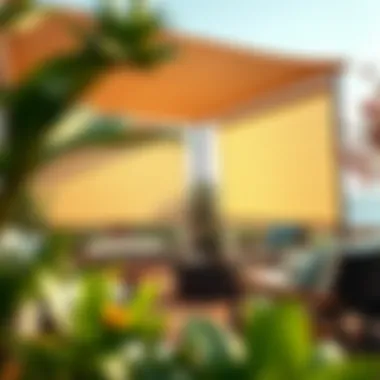

Fixed Frame Shades
Fixed frame shades are a reliable choice when you want a more permanent solution. These shades are typically installed within a sturdy frame that remains in place year-round. This type design is excellent for areas that face direct sunlight for extended periods straight through the day. Unlike retractable shades, you won’t have the option to roll them up, but their solid structure provides a sense of stability and durability.
Key Highlights of Fixed Frame Shades:
- Durable Construction: Often made to withstand harsh weather conditions over time.
- Aesthetic Appeal: Offers a sleek, integrated look within architectural elements.
- Consistent Protection: Provides ongoing UV protection and privacy without the hassle of retraction.
Motorized Options
For homeowners seeking a blend of technology and convenience, motorized outdoor screen shades fit the bill perfectly. These shades can be operated electronically, providing ease of use at your fingertips. With motorized shades, you can control them via remote, smartphone app, or even integrate them into your smart home system. This modern technology offers an elevated way to enjoy your outdoor spaces with just a few clicks.
Advantages of Motorized Shades:
- Convenience: Effortlessly operated, which can be a blessing for hard-to-reach areas.
- Smart Integration: Can be programmed to open or close at specific times, which enhances energy efficiency.
- Aesthetic Freedom: Available in a variety of designs and styles to match personal preferences.
In choosing the best type of outdoor screen shade, consider how you plan to use the space, daily sunlight exposure, and overall comfort. It’s not just a simple addition; it’s an enhancement that affects your lifestyle. Understanding your choices puts you one step closer to creating a comfortable and stylish outdoor atmosphere.
Materials Used in Outdoor Screen Shades
The materials chosen for outdoor screen shades play a crucial role in determining their effectiveness, durability, and aesthetic appeal. Understanding these materials ensures that homeowners and designers alike can make informed decisions on what best suits their outdoor environment. From fabric choices that can block UV rays to frames that can withstand the elements, being knowledgeable about materials aids in maximizing the value of these shades. Moreover, the right materials enhance the visual design and functionality while decreasing maintenance needs.
Fabric Choices
When it comes to outdoor screen shades, the fabric is often the star of the show. The selection here impacts not only how the shade looks but also how it performs. Popular options include polyester, vinyl, and woven fabrics.
- Polyester: Known for its strength and resistance to stretching or shrinking. It offers excellent protection against the sun, making it a top choice.
- Vinyl: This fabric is often coated for added durability. It is resilient against moisture, making it suitable for areas with high humidity.
- Woven fabrics: These typically provide a more natural look. They can also balance light and shade effectively, allowing for varying degrees of privacy depending on the weave.
Ultimately, the right fabric choice can protect your outdoor furniture and create a comfortable ambiance while ensuring longevity.
Frame Materials
The frame is the backbone of your outdoor screen shades, giving them structure and support. The durability of the frame is essential, especially since outdoor conditions can vary wildly. Common materials for frames include aluminum, steel, and fiberglass.
- Aluminum: Lightweight and resistant to rust, aluminum is often favored for its balance of strength and functionality. Many manufacturers powder coat it to enhance its aesthetic qualities.
- Steel: While heavier, steel frames offer excellent strength and support. If treated correctly, they can fend off rust and corrosion, thus extending their lifespan.
- Fiberglass: This material is resistant to both rust and corrosion and is lighter yet exceptionally tough. With innovative designs, fiberglass frames can blend seamlessly with the fabric, offering both form and function.
An ideal frame material not only supports the fabric but also integrates effortlessly with the overall design aesthetic of the outdoor space.
Weather Resistance
Outdoor screen shades are exposed to a myriad of weather conditions, hence weather resistance in both fabric and frame materials cannot be understated. Different climates demand different characteristics from screen shades.
- UV Resistance: Fabrics should be treated to resist fading under direct sunlight. This ensures the shades maintain their color and effectiveness over time.
- Water Resistance: Materials that repel moisture can prevent mold and mildew development, especially in humid climates. This is crucial for the longevity of the shades and enhances user safety.
- Wind Resistance: Consideration must be given to how well the installation can withstand gusty winds. Shade designs (like retractable options) can be phenomenally effective in minimizing potential damage.
Selecting weather-resistant materials ensures outdoor screen shades remain durable, maintaining both their functionality and appearance through all seasons.
Properly chosen materials in outdoor screen shades are not merely about aesthetics; they are paramount in providing comfort, functionality, and ease of use.
Benefits of Outdoor Screen Shades
Outdoor screen shades can dramatically enhance the experience of any outdoor space, providing more than just aesthetics. They serve essential roles such as improving comfort and safety, which makes them worthy of consideration for any homeowner, designer, or outdoor enthusiast. Beyond the basic function of blocking sunlight, these shades come equipped with a plethora of benefits that can elevate the outdoor living experience.
UV Protection
One of the most significant advantages of outdoor screen shades is their ability to provide advanced UV protection. Prolonged exposure to ultraviolet rays can lead to skin damage and even increase the risk of skin cancer. Outdoor screen shades act as a protective barrier, filtering out a substantial portion of harmful UV rays.
"Investing in outdoor screen shades not only protects your skin but preserves your outdoor furniture from fading, keeping your space looking fresh for longer."
Different fabrics and materials have varying degrees of UV resistance. For instance, materials like acrylic and polyester often provide better protection, while still allowing pleasant diffused light. Homeowners can choose shades with specified UV ratings to meet their needs. The thought of lounging under a shade that adds both beauty and safety can be quite appealing.
Enhanced Privacy
In a world where privacy is often at a premium, outdoor screen shades can offer a much-needed retreat. These shades allow homeowners to enjoy their outdoor space without the prying eyes of neighbors or passersby. Whether it's a backyard barbecue or a peaceful morning with a book, the added level of seclusion can make all the difference.
Selecting the right design and fabric plays a crucial role in achieving this sense of privacy. Some shades are designed to obstruct visibility from the outside while allowing those inside to see out. This dual-function is perfect for outdoor areas that sit close to public spaces. Opting for darker colors or thicker materials can enhance privacy further.
Temperature Regulation
Outdoor screen shades don't just help with aesthetics and privacy; they also play a significant role in temperature regulation. During the scorching summer months, these shades can keep spaces cooler by blocking out direct sunlight and reducing heat buildup. This can lead to a noticeable decrease in energy consumption when cooling outdoor areas or adjacent indoor spaces.
In winter, some outdoor screen shades can help conserve heat by acting as an insulating barrier against chill winds. Investing in high-quality shades that perform well in both seasons means maximizing utility throughout the year. This benefit not only adds comfort but can also lead to lower utility bills, giving a significant edge in terms of cost-efficiency.
Installation Considerations
For many homeowners and designers, the installation of outdoor screen shades isn't just a simple task; it’s a crucial step that can greatly influence the overall enjoyment and performance of outdoor spaces. Proper installation affects not only the aesthetics but also the functionality and durability of shades.
DIY Installation vs Professional Help
When it comes to installing outdoor screen shades, one big decision arises: should you take the DIY route or hire a professional? Going the DIY way can save you some bucks, and many homeowners love the satisfaction of saying they did it themselves. However, it’s important to consider your own skill level and the complexity of the installation process.
- Pros of DIY:
- Cons of DIY:
- Cost-effective; save on labor costs.
- Sense of achievement after completing the task.
- Flexibility in timing and working at your own pace.
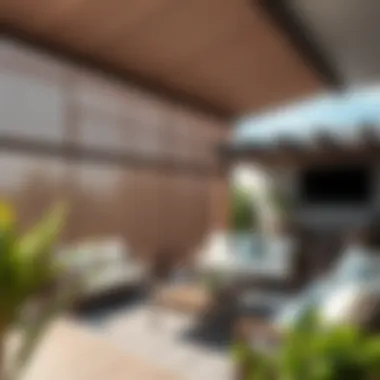

- Potential for mistakes; installation errors could lead to additional costs later.
- Time-consuming if you’re not experienced.
- Lack of professional finish.
On the other side, hiring a pro might lead to an upfront expense but guarantees a sleek finish and peace of mind. Experienced installers properly calculate the dimensions and ensure that the shades fit seamlessly into the outdoor area, enhancing the functionality.
Choosing the Right Location
Choosing where to place your outdoor screen shades is not merely a matter of aesthetics; it involves strategic planning. It’s vital to assess the sunlight patterns throughout the day. Are there areas that get baked by the afternoon sun? Or spots that provide shielding without blocking your lush garden’s view?
Here are some considerations:
- Identify sun exposure: Areas that receive maximum sunlight might need shades or screens with higher UV protection.
- Wind patterns: Sheltering screens in areas exposed to strong winds can prolong their lifespan.
- Functionality: Think about how you intend to use the space. If it's primarily for lounging, prioritize comfort; if for dining, proximity to the table is key.
Pro tip: Take a walk around your property at different times of the day to get a feel for sun and shade patterns. It's a small effort that can have big rewards in your screen shade placement.
Measuring for Fit
Measuring correctly is perhaps one of the most critical steps in the installation process. Incorrect measurements can lead to ill-fitting shades, which can affect both aesthetic and operational functionality.
- Tools Required: A measuring tape, pen, and paper for notes. An extra pair of hands can also be helpful.
- Steps for Accurate Measurement:
- Width Measurement: Measure the width of the area where the shade will hang. Make sure to account for any obstructions such as window frames or decorative trim.
- Height Measurement: Measure from the mounting point (often above or to the side of the window or porch) down to where you want the shade to stop.
- Final Check: Always measure twice to avoid costly mistakes.
"Measure twice, cut once."
This age-old adage holds especially true in the world of DIY home installation.
In summary, the installation of outdoor screen shades is a well-thought-out process that requires careful consideration and planning. By weighing your options between DIY versus professional help, choosing the optimal location, and ensuring precise measurements, we can enhance both the beauty and function of outdoor spaces, making them an enjoyable retreat all year round.
Maintenance and Care
Taking good care of outdoor screen shades is not just a chore; it’s a vital part of ensuring their longevity and functionality. On a basic level, regular maintenance helps keep these shades looking good and operating smoothly. When you invest in outdoor screen shades, it’s important to remember they face the elements day in and day out. Sun exposure, rain, and even dirt can take a toll. Thus, understanding the nuances of maintaining these installations is crucial.
Cleaning Techniques
Cleaning your outdoor screen shades is pritty straightforward, yet many homeowners overlook this vital task. Regularly wiping down the shades with a damp cloth helps remove dust and debris that accumulate over time. For deeper cleans, a gentle mix of mild soap and water will do the trick. Just be cautious not to use abrasive cleaners as they can scratch the surface.
- Tip: Use a soft-bristled brush to gently scrub away stubborn stains.
- Make sure to rinse thoroughly afterward to prevent soap residue from building up.
In the case of fabric shades, utilizing a specialty cleaner designed specifically for outdoor materials can help preserve color and texture. Keep in mind, it’s also wise to check the manufacturer’s guide for specific cleaning suggestions.
Regular Inspections
Conducting regular inspections of your outdoor screen shades should be part of your routine. This doesn't have to be excessive, but at least once or twice a season is a good practice. Check for any wear and tear, rust on the frame, or signs of mold and mildew which can develop in more humid areas. Catching these issues early can save you a fair bit of trouble down the line.
- Look for:
- Tearing in the fabric
- Broken mechanisms if it’s a retractable type
- Any hardware that may need tightening
An inspection can also serve as a reminder to adjust the tension in motorized shades to ensure they function correctly. If you spot something amiss, it's worth addressing the issue right away before it escalates into bigger problems.
Repair Options
No matter how well you take care of your outdoor screen shades, there might come a time when repairs are needed. Understanding your options can save you time and potentially money. Most damages can be repaired without having to replace the entire installation.
- Small tears or rips in fabric shades can often be mended with fabric glue or patches designed specifically for outdoor materials.
- Dents or bends in metal frames might be able to be straightened out if the damage isn't extensive.
If you're not comfortable making repairs yourself or if the damage is substantial, seeking professional help can be a smart move. Many manufacturers offer repair services, and there are specialists in your area. The key here is to act quickly; a little fix can turn into a larger headache if ignored.
"Maintaining your outdoor screen shades is an investment in your comfort and aesthetics."
Energy Efficiency and Outdoor Screen Shades
Outdoor screen shades play a significant role in enhancing the energy efficiency of your home. They are not just mere accessories that serve to block out the sun; rather, they are smart tools that can contribute significantly to reducing energy consumption. With rising energy costs and growing environmental concerns, understanding how these shades function can lead to both ecological and economical benefits.
Heat Reduction in Summer
During those sweltering summer months, outdoor screen shades are your best friends. They act as a barrier that reflects and absorbs heat from the sun before it enters your home. Instead of depending on your air conditioning system to keep the indoor space comfortable, these shades can reduce heat gain by up to 75%. This simple yet effective solution cuts down on the need for excessive cooling, resulting in lower energy bills.
- Benefits of Heat Reduction:
- Reduced reliance on air conditioning, leading to energy cost savings.
- Longer lifespan for your cooling systems due to less strain.
- Enhanced comfort in outdoor areas, making your patio or deck a much more enjoyable space.
By blocking harmful UV rays, these shades don’t just protect your furniture from fading; they also maintain a cooler environment in both indoor and outdoor settings. Depending on the material selected, they can provide varying levels of opacity and insulation, allowing you to customize the heat level and light flow to your liking.
Winter Benefits
While most people associate outdoor screen shades with cooling, they also offer unique advantages during the winter. Surprisingly, these shades can help trap warmth inside the home, enhancing your heating efficiency. Specifically, they can prevent cold winds from seeping indoors, thereby reducing the amount of energy needed to keep spaces cozy.
- Key Winter Benefits:
- Insulation properties that retain heat within the house.
- Protection from drafts, making indoor living spaces more comfortable.
- Decreased heating costs as a result of improved energy efficiency.
As the cold weather rolls in, shades that have thermal and insulating capabilities weigh heavily in your favor. Not only do they keep the chill at bay, but they also ensure your heaters don't have to work overtime, contributing to longer-lasting appliances and lower utility costs.
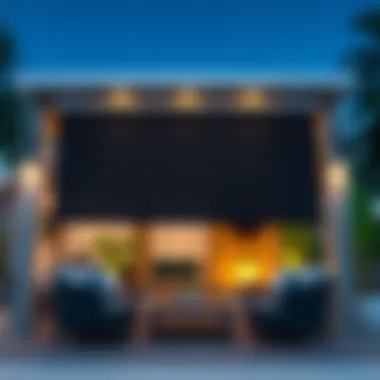

"Incorporating outdoor screen shades is not just about aesthetics; it’s about making a lasting, positive impact on your energy usage year-round."
Design Trends in Outdoor Screen Shades
Staying in touch with design trends is crucial, especially when it comes to outdoor spaces, where functionality and aesthetics walk hand in hand. Outdoor screen shades not only serve practical purposes such as blocking the sun’s glare and enhancing privacy but also greatly impact the overall visual appeal of an outdoor area. As outdoor living becomes more integrated into daily life, the design elements surrounding outdoor screen shades have evolved, ensuring that they blend seamlessly into contemporary landscaping and home styles.
Color and Style Trends
The color palette of outdoor screen shades can significantly steer the mood of a patio, deck, or garden area. Traditionally, neutral tones like beige and gray were predominant, but nowadays, more homeowners are experimenting with bolder colors. Rich navy blues, forest greens, and even vibrant yellows are making their way into outdoor design. This shift is reflective of a broader movement towards personalized spaces where individual expression reigns supreme.
Moreover, sustainable materials are rising in popularity. Shades produced from recycled fabrics not only offer environmental benefits but also come in an impressive array of colors and textures. They allow homeowners to make eco-conscious choices without sacrificing style. On the flip side, patterns such as stripes or geometric designs are quite trendy, echoing the aesthetics of the current interior design landscape, thereby extending the home’s style to outdoor areas.
Integration with Outdoor Decor
Incorporating outdoor screen shades with existing outdoor decor hinges on creating a harmonious and inviting atmosphere. The challenge lies in ensuring that shades do not appear as an afterthought but rather as a cohesive part of the overall design. Choosing shades that complement outdoor furnishings—be it a wooden pergola, wrought iron furniture, or contemporary lounge chairs—can enhance the visual unity of the space.
Furthermore, consider how your shades interact with natural elements. For instance, if you have a garden filled with colorful blossoms, opt for shades that enhance, rather than detract from, this natural beauty. Look to nature for motivation; earthy tones tend to harmonize with green landscapes, while brighter shades can inject a lively energy.
Outdoor decor often benefits from layering textures. Think about adding cushions or throws in similar shades to create a polished look. Use solid colors for the shades but bring in patterns via outdoor textiles to break the monotony and spark interest. This method fosters a well-curated appearance.
Embracing innovative design trends in outdoor screen shades can transform mundane outdoor spaces into vibrant retreats with personality and purpose.
The growing trend of shade structures that go beyond basic functionality opens the floor to customized solutions. Some designers and architects now offer bespoke options, ensuring the shades fit precisely to individual preferences and unique outdoor layouts. This trend speaks to both versatility and luxury, catering to the increasingly discerning tastes of homeowners today.
In summary, the design trends in outdoor screen shades emphasize a blend of color, style, and integration with other aspects of outdoor decor. By making strategic choices in these areas, homeowners can elevate their outdoor environments, making them more enjoyable and visually appealing.
Cost Considerations
Understanding the costs associated with outdoor screen shades is a crucial aspect of making an informed decision. These shades offer a range of benefits, but their price point varies significantly based on multiple factors, including materials, installation options, and additional features. Knowing what influences these costs can guide homeowners, designers, and even DIY enthusiasts in budgeting effectively for their outdoor projects.
Budgeting for Outdoor Screens
When starting on the project of incorporating outdoor screen shades into an outdoor space, it’s vital to set a realistic budget. Prices for these shades can fluctuate due to several influencing factors. To make the budgeting process easier, consider the following aspects:
- Material Choices: Different fabrics, such as vinyl or screen mesh, come with their own price tags. Vinyl, known for its durability and UV resistance, may cost more upfront but can save you in replacements in the long run.
- Size of Installation: Larger spaces require more material, which will ultimately raise costs. It’s wise to measure your area properly to avoid unexpected expenses.
- Installation Method: Opting for DIY installation can save a chunk of change, but if you're not handy, hiring professionals can be a sound investment to ensure correct setup and functioning.
Budgeting is not just about setting a number; it’s also about considering future maintenance and energy savings. A higher initial investment in quality shades can lead to long-term benefits.
Understanding Pricing Variations
The prices for outdoor screen shades can vary widely depending on various elements. Here’s what to keep in mind when navigating these costs:
- Brand Influence: Established brands such as ShadeZone and SunSetter offer pieces that come with a warranty and proven reliability but typically carry a higher price. New entrants in the market might offer cheaper solutions but could lack the same quality or customer support.
- Customization Options: Tailored shades that fit your specific style or size will likely cost more than off-the-shelf models. Custom colors, patterns, or sizes can add to the base price.
- Technology Features: If you’re leaning towards motorized options, keep an eye on additional expenses related to the technology. Remote control features or smart integrations can up the price but add convenience.
- Seasonal Sales and Promotions: Timing can affect costs, too. Events like Memorial Day or Black Friday may offer discounted prices on outdoor screen shades, allowing you to snag a better deal.
"Investing in quality shades can lead to reduced energy costs and a more enjoyable outdoor experience."
For further reading and insights on budgeting for your outdoor enhancements, consider checking out Wikipedia’s guide on home improvement or join discussions on Reddit for user experiences and tips.
Regulatory Considerations
When it comes to outdoor screen shades, understanding the regulatory landscape is paramount. Local laws and the governing rules set by homeowners associations play a significant role in determining what kind of screens can be installed and how they should be used. Ignoring these regulations can lead to fines and the arduous task of removing non-compliant installations. Thus, this section aims to clarify these pivotal considerations, providing insights for homeowners and designers alike.
Local Building Codes
Local building codes are a framework of policies dictating the safety and functionality of construction practices within a community. When it involves outdoor screen shades, these codes often specify various factors such as height, materials, and even colors that are acceptable in certain neighborhoods.
It's important to recognize that building codes can vary significantly from one municipality to another. For instance, in a coastal area prone to hurricanes, there may be stricter regulations regarding the materials used, to ensure they can withstand high winds. This is a far cry from urban settings where regulations may focus more on aesthetic integration with surrounding architecture.
Before embarking on the installation of outdoor screen shades, homeowners should:
- Check with local authorities: Consulting the city or county planning office is essential. They provide information on current building codes and any necessary permits.
- Review guidelines for specific materials: Some materials may be restricted based on fire safety standards or environmental concerns.
- Consider setbacks and heights: Regulations often dictate how far structures need to be from property lines and how high they can be, requiring careful planning in the installation process.
Homeowners Association Guidelines
Homeowners associations (HOAs) often have their own set of rules that pertain to aesthetics and community standards. While these guidelines are generally geared toward maintaining property values and visual homogeneity, they can also affect the installation and design of outdoor screen shades. For example, some HOAs may restrict colors to maintain a consistent neighborhood appearance or impose limits on the type of frames that can be used.
To navigate HOA guidelines successfully, homeowners should:
- Attend HOA meetings: Getting involved with neighborhood discussions can offer deeper insights into the community's expectations and any ongoing criteria reviews related to outdoor structures.
- Request design approval: Many HOAs require homeowners to submit proposals and gain approval before undertaking any significant exterior projects, including installing screen shades.
- Familiarize yourself with existing landscaping rules: The installation of outdoor screen shades should not interfere with current landscaping arrangements or configurations, which can also be dictated by HOA policies.
"Understanding the fine print of local codes and HOA guidelines can save you from unnecessary headaches in the long run."
Closure
The discussion around outdoor screen shades can be summed up in a few vital points that not only highlight their usefulness but also underscore their significance in enhancing outdoor living spaces. As homeowners, designers, and enthusiasts explore options for improving the aesthetics and functionality of their properties, understanding outdoor screen shades emerges as an invaluable asset.
Recap of Key Points
Outdoor screen shades serve multiple purposes that make them a desirable choice for many. Firstly, they provide exceptional UV protection, safeguarding both people and furniture from harmful rays. Secondly, their ability to enhance privacy is a significant draw, creating intimate spaces in otherwise open environments.
- Diverse Types: Choices range from retractable screens to fixed frame and motorized options, allowing flexibility based on personal needs and space.
- Material Quality: The right fabric and frame materials can greatly influence durability and performance under various weather conditions.
- Installation Options: Whether opting for a DIY route or professional installation, proper planning and execution ensure that screens fulfill their purpose effectively.
- Energy Efficiency: Not to be forgotten, these shades contribute to energy savings by regulating temperatures, keeping spaces cooler in the summer and insulating against winter chill.
The above considerations make it clear that outdoor screen shades are not merely decoration; they are functional enhancements that protect and beautify spaces.
Future Outlook
Looking ahead, the future of outdoor screen shades appears promising, as innovation continues in design and functionality. Manufacturers are likely to introduce more energy-efficient materials that not only promise longevity but also enhance aesthetic appeal. Additionally, the integration of smart technology in motorized options may become more prevalent. Owners could control their shades via smartphone apps or integrated smart home systems, which adds convenience and enhances user experience.
Furthermore, as environmental consciousness grows, eco-friendly options are likely to rise in popularity, making it easier to find shades that are both stylish and sustainable.
